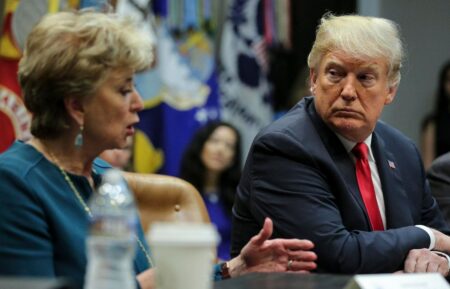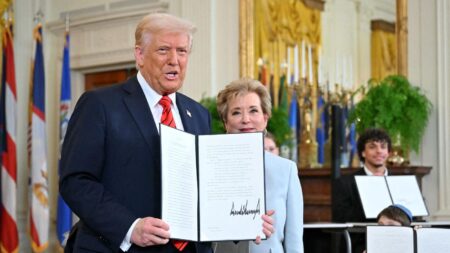Last week, in a widely expected move, President Donald Trump signed an executive order to close the U.S. Department of Education. After the White House provided assurances that the federal student loan system would remain with the department pending congressional action (which would likely be required to formally shut it down), Trump announced that he would be transferring federal student loans, and the administering of all associated repayment and loan forgiveness programs, to the Small Business Administration.
The announcement that student loans would be transferred to the SBA baffled many observers, as the relatively small agency has no experience managing the vast, $1.5 trillion federal student loan system. The Trump administration has also imposed substantial staff cuts on the SBA (as it has on the Department of Education as well), leading to questions about how the SBA could even handle such a significant addition to its existing responsibilities with far fewer staff. And legal experts have noted that the unilateral transfer of the federal student loan system to another federal agency via executive action may violate federal law.
Here’s what student loan borrowers should know about President Trump’s announcement that he would transfer federal student loans to the SBA.
Can Trump Transfer Federal Student Loans From the Department Of Education To The SBA Through Executive Action?
Legal observers have called into doubt President Trump’s ability to transfer federal student loans unilaterally through executive action. Congress established the Office of Federal Student Aid as a unit within the Department of Education. FSA oversees most of the federal student loan system including loan repayment, student loan forgiveness and discharge, servicer oversight, the FAFSA, and the disbursement of new federal student aid. It would likely take an act of Congress to allow FSA to be moved to a different agency.
Furthermore, Congress specifically directed federal student loan programs, including repayment and loan forgiveness programs, to be carried out by the Secretary of Education. For example, under the statute that Congress passed authorizing the creation of Income-Based Repayment, the statutory text says that the Secretary of Education “shall carry out a program” that allows borrowers to repay their student loans based on a formula applied to their income and family size, and the “Secretary shall repay or cancel any outstanding balance of principal and interest due on all loans” after 25 years.
Similarly, for the Public Service Loan Forgiveness program, the authorization statute says that the Secretary of Education “shall cancel the balance of interest and principal due, in accordance with paragraph (2), on any eligible Federal Direct Loan not in default for a borrower who— (A)has made 120 monthly payments on the eligible Federal Direct Loan after October 1, 2007” that meet PSLF program’s eligibility rules.
For both IBR and PSLF (and similar programs), Congress’s use of the world “shall” means that the directive is mandatory, and a president cannot simply change statutory text. As a result, many observers agree that President Trump cannot simply move federal student loan programs to an agency outside of the Department of Education without congressional authorization.
“The President and his agents have no authority to unilaterally close a Cabinet-level agency created by Congress or to reassign its functions elsewhere,” argues the NAACP and a coalition of labor unions in a legal challenge filed against the Trump administration earlier this month over efforts to shut down the Department of Education.
Can Congress Authorize The Transfer Of Student Loans From The Department of Education To Another Agency?
But Congress is another story. Congress could pass legislation to close the Department of Education, or transfer federal student loan operations to another federal agency.
It’s unclear if Republicans, who narrowly control the House and the Senate, are planning on including such a directive in a massive reconciliation bill currently under development that is primarily intended to extend tax cuts that are set to expire at the end of 2025. The reconciliation process allows lawmakers to bypass the Senate filibuster, providing a pathway to enact laws through simple majorities (otherwise, at least some Democrats would have to join with Republicans to pass legislation, and it’s unlikely that there would be sufficient numbers of Democrats willing to close the Department of Education).
Congress is already considering including a number of other proposals in the reconciliation bill that would dramatically reshape the federal student loan system, including ending the student loan interest deduction, taxing scholarships, and phasing out the issuance of new Graduate PLUS and Parent PLUS loans.
Would Transferring Student Loans Invalidate Their Contracts?
Under the federal student loan Master Promissory Note for the Direct lending program, the “lender” is listed as the Department of Education.
“I promise to pay to ED the full amount of all loans that I receive under this MPN in accordance with the terms of the MPN, plus interest and any other charges and fees that I may be required to pay under the terms of the MPN,” reads the note (“ED” means the Department of Education). If President Trump were to unilaterally transfer the Direct federal student loan system to a different federal agency, it could raise questions about who, specifically, borrowers are obligated to repay, given the promissory note language. As noted, any such transfer without congressional authorization could potentially violate federal law.
But Congress could step in and amend the Higher Education Act, the statute that governs much of the federal student loan system (including repayment and student loan forgiveness). An amendment could direct borrowers to send payments to a different federal agency, and put that agency in charge of administering the federal student loan system. Any such amendment to the Higher Education Act would likely be allowable under the terms of the Master Promissory Note.
“Amendments to the Act may change the terms of this MPN,” reads the contract. “Any amendment to the Act that changes the terms of this MPN will be applied to your loans in accordance with the effective date of the amendment. Depending on the effective date of the amendment, amendments to the Act may modify or remove a benefit that existed at the time that you signed this MPN.”
Would Transferring Student Loans Impact Any Existing Loan Forgiveness Or Repayment Programs?
Ultimately, if the federal student system does wind up getting transferred to another agency (which, again, would likely require congressional approval), it should not change the ability for borrowers to access repayment and student loan forgiveness programs – unless Congress also changes those programs through legislation. Some advocacy groups are concerned, though, that the ability of borrowers to access these programs could be compromised if the new agency is not adequately equipped to operate the Department of Education’s massive student loan portfolio.
“During the COVID-19 pandemic, SBA was charged with administering loans representing a ninefold increase in their normal business,” said the Institute for College Access and Success in a statement earlier this month. “Since then, the Office of the Inspector General has documented how inadequately the small agency’s systems and staff were able to detect and prevent fraud and effectively service and oversee billions of dollars of loans—wasting large amounts of taxpayer dollars in the process. With zero prior planning, history is doomed to repeat itself. By cutting 40 percent of SBA staff while at the same time tasking the agency with taking on a more than $1.5 trillion loan portfolio, system failure is inevitable.”
While student loans themselves shouldn’t change solely as a result of an agency transfer, Congress could pass legislation to amend or change these programs. And that very well could happen. Lawmakers are considering including in the upcoming reconciliation bill major reforms including repealing several Biden-era rules governing student loan forgiveness and discharge, remaking the federal student loan repayment system, and changing eligibility for PSLF.
Read the full article here











